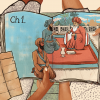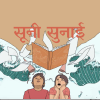The story of suffering and sacrifice, and the meaning of sin and redemption have penetrated the imaginations of writers across India over the centuries. Public worship, poetry pleading to share in the Saviour’s pain, narrative poems on martyrdom, and comparative theology have all been inspired by the theme of Christ’s Passion, and have been acknowledged as bringing new life to lndian languages as well as to Christian theology.[i]
From the 17th century, Christi Vilapika, or Paixao de Christo (poems on the Passion of Christ) were written in Marathi, and in 1621, the traveller Father Alex Rhodes refers to ‘a very fine poem on the Passion of Our Lord’ being sung in Church in the evenings of all Lent Fridays: ‘the devotion lasted for a larger part of the night, with an attendance so large, that from Goa itself ordinarily ten to twelve thousand persons came to take part in this beautiful devotion.’[ii]
Writing of Christ’s death in 1879, the Rev. ‘Imad ud Din (1830–1900) of Church Mission Society (CMS), who ‘laid the foundations of Urdu Christian literature, and pioneered the exposition of an Islamically enculturated evangelical faith’[iii] distinguished the person of Christ from the Church[iv]:
Christ and Christianity are not to be confounded with one another. Christ is the blessed name of Him in whom Deity and manhood are united. Christianity is the result of His dying and of His teaching and example. The attention of the Church is too much given to the teaching and example of Christian people, and is too little given to the Lord Himself, whom to know is life everlasting. Therefore, the Church's spiritual life is stunted. It learns so little by gazing at itself. When the Church sets her eye on Christ, her Christianity will be all glorious within.
Contemplating the figure of Christ crucified, the Marathi hymns of Narayan Vaman Tilak (1862–1919) enact a process of recognizing and rejecting his sin, and of self surrender that his biographer J.C. Winslow distinguishes from propounding ‘subtle doctrine of the Atonement'[v]:
Hast thou seen who that one is who has hurt Him so?
Hast thou seen the sinner, cause of all His woe?
Hast thou seen how He, to save, suffers thus and dies?
Hast thou seen on whom He looks with His loving eyes?
Hast thou ever, ever seen love that was like this?
Hast thou given up thy life wholly to be His?
Another of Tilak’s hymns on Christ’s sacrifice addresses him as ‘Tenderest Mother-Guru mine’, which David Emmanuel Singh relates to an Indian familial context[vi]:
For me, a sinner, yea for me
He hastened to the bitter tree
And still within me living too
He fills my being through and through
My heart is all one melody
Hail to thee, Christ, all hail to thee
Singh also studies how in the Urdu poems of Sadhu Sundar Singh (1889–1929), Christ’s sacrifice transfigures the human experience of suffering[vii]:
Through suffering God strikes us in love. The Cross is the key to heaven…The Cross will hear those who bear the cross, until it bears them up to heaven, into the actual presence of the glorious Redeemer.
According to Israel Selvanayagam, by drawing on ancient Tamil literature and Saiva and Vaishnava traditions, Tamil poets produced work of unmatched richness and laid the foundations for a Tamil Christian theology. He discusses how H.A. Krishna Pillai (1887–1900) uses the ancient image of a lover’ self-sacrifice for Christ’s sacrifice.[viii] More recently, Thomas Thangaraj (b. 1942), produces a ‘singable’ and ‘contextual’ theology, where the ‘crucified guru’ is contrasted to the Saiva understanding of guru.[ix]
In 1931, the Kannada writer M. Govinda Pai (1883–1963) wrote Golgotha, an extended narrative poem on the Passion, opening with Pilate’s judgement.[x] An outline of the poem, showing how it unfolds Pilate’s obtuseness and weakness, and its treatment of Mary Magdalene is given by N. Thirumaleshwara Bhat,[xi] who also reflects on how Christ’s martyrdom is different from the deaths of the Buddha, Krishna and Gandhi, about which Govinda Pai wrote subsequently. Scenes from the crucifixion are excerpted here:
A Friday it was, a day of the full moon
In spring. Midday, but no sign of the sun,
The sky was overspread with a vast cloud
Like that end-of-the-world cloud Noah has witnessed.
The heat unbearable. No breeze, only the earth
Gasping. Tree’s leaves unstirring. Breathless the birds.
Midnight-like but the people, not quietly
Staying home, moved like a python, crowding
Like swarms of grasshoppers, beyond the gates
Of Jerusalem to the mount of Golgotha,
Meaning the place of a skull.
…
And Jesus looking
Like a quail in a vulture’s clutches, like a slip of the moon
In the west, like a shaft in a bow drawn, like the fruit
On death’s tree, of immortality and saying, “Pain
Is inherent in the body, no man can escape it,” endured
With cool fortitude the agonising crucifixion
As a mother, when the child looks up at her face, bears
Her travail or as a soldier in the vanguard, unmindful
Of his many wounds fights till he dies
A victor and uttered these words like a mother dying
Whose only thoughts are of the children she is leaving
Or a tree which offers its shade to its own hewers,
“Forgive them, Father, for they know not what they do.”
The closing lines of the poem:
Then the moon rising from behind Golgotha,
Raises over the undying dead one its white
Umbrella and like his fame’s milky stream
And like the purity of his precept and example
And like the immortal nature of his soul
Moonlight spreads and everywhere there is stillness
And everywhere peace, peace everywhere.
Malayalam is perhaps the Indian language most deeply permeated by Christianity. On the west coast of Indian subcontinent, the region had a longer association with Christianity than any other part of the country, being home to one of the world's most ancient Christian communities, together with Egypt and Ethiopia.
Later missionaries influenced the Malayalam language as a whole, and the Bible as a text, its language, and the life and message of Christ have been an inspiration to writers since the 19th century. In modern Malayalam literature, one sees this reflected in the works of Arnos Pathiri/ Johann Ernst Hanxleden in his epic poem ‘Puthan Paana’, in Vallathol Narayana Menon’s poem ‘Magdalana Mariam’, in G. Sankara Kurup’s poem referring to the crucifixion, ‘Innu Njan Naale Nee’, in C.J. Thomas, Ponkunnam Varkey, Mundasseri, Vaikom Muhammad Basheer (in ‘Aanavariyum Ponkurishum’, a story bringing out the evolution of Kerala’s secular fabric and the influence of the church), Ponjikkara Rafi, Sabeena Rafi, Changapuzha Krishna Pillai, Vayalar, P. Bhaskaran, Mary John Koothaattukulam, Ayyappa Panikar, Kakkanadan, T.K.C. Vaduthala, Parappurathu, K. Satchidanandan, Sarah Joseph (the novel Aalakhayude Penmakkal), D Vinayachandran, A. Ayyappan (many of whose poems reflect deeply on Christ’s suffering and the crucifixion), Paul Zachariah (in many works relating to the Christian experience and the centrality of its ethos to Kerala life, and in the syntactical influence of Biblical language and Christian colloquialisms), Balachandran Chullikkad (many poems, in particular ‘Mother Theresakku Maranamundenkil’), N.S. Madhavan (the novel Lanthan Batheriyile Luthiniyakal, story ‘Vanmarangal Veezhumbol’, the stories in Thiruthu, and the allegory, ‘Velipaadukal’), C.V. Balakrishnan, Aymanam John, K.R. Tony, Gracy, P.F. Mathews, Thomas Joseph, Joseph Marian, George Joseph and S. Joseph.
English translations of some poems of K. Satchidanandan can also be referred.
Notes
[i] Selvanayagam, Israel. 2008. ‘Protestant Attempts at Theologizing in India’, in Christian Theology in Asia, ed. Kim. Cambridge: Cambridge University Press, pp. 41–70; and Hephzibah Israel. 2011. Religious Transactions in Colonial South India: Language, Translation, and the Making of Protestant Identity. New York: Palgrave Macmillan.
[ii] Tadkodkar, S.M. 2009. Goan Christian Marathi Vilapika during the 17th Century. Delhi: B.R. Publications; the quotation from Father Rhodes is from Tadkodkar’s ‘Christian Marāthi Literature in Goa’, September 22, 2012.
[iii] Anderson, Gerald H. ed. 1999. Biographical Dictionary of Christian Missions. Michigan: William. B. Eerdmans Publishing, p. 317.
[iv] Clark, Robert. ed., 1885 The Punjab and Sindh missions of the Church Missionary Society. Giving an account of their foundation and progress for thirty-three years, from 1852 to 1884. London: Church Missionary Society, p. 266, available here.
[v] Winslow, J.C. 1923. Narayan Vaman Tilak: The Christian Poet of Maharashtra. Calcutta: Association Press, p. 102, available here.
[vi] Singh, David Emmanuel. 2005. ‘Sunder Singh and N.V. Tilak: Lessons for Missiology from 20th century India’, May 19, 2005, p. 3, available here.
[vii] Ibid. p. 5.
[viii] Selvanayagam, Israel. 2008. ‘Protestant Attempts at Theologizing in India’, pp. 57–58; here Selvanayagam cites R.S. Sugirtharajah, ‘Thinking about Vernacular Hermaneutics sitting in a Metropolitan Study’, in Vernacular Hermaneutics, ed. R.S. Sugirtharajah (Sheffield: Sheffield Academic Press, 1999), p. 99. See also Hephzibah Israel, Religious Transactions in Colonial South India (2011), whose concluding chapter contrasts poetry by Tamil Christians to translations by European missionaries.
[ix] Selvanayagam, Israel. 2008. ‘Protestant Attempts at Theologizing in India’, pp. 59. See also T. Thangaraj (1994), The Crucified Guru: An Experiment in Cross-Cultural Christology. Nashville: Abingdon Press.
[x] Shivaprakash, H.S. and K.S. Radhakrishna. (eds.) 1990. A String of Pearls. Bangalore: Karnataka Sahitya Academy, excerpted in BA Viveka Rai’s blog, January 19, 2012.
[xi] Bhat, N. Thirumaleshwara. 1993. Govind Pai. New Delhi: Sahitya Akademi, pp. 57–63.










